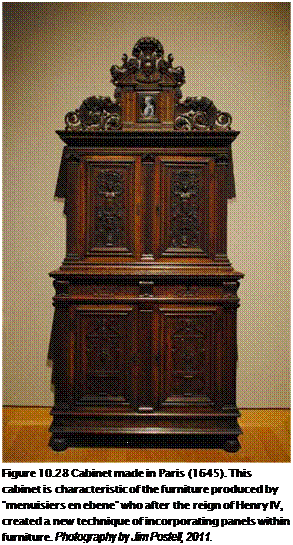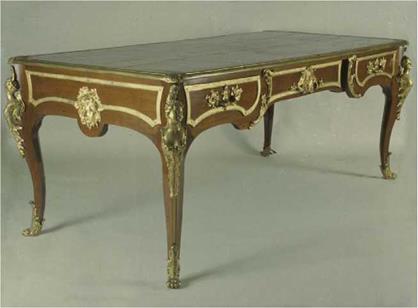The Baroque period began in the seventeenth century, originating in southern Europe, and extended into the early eighteenth century. The Baroque style was influenced by the Bourbon dynasty (1589-1789) and by the prevailing fashions in Italy, France, Spain, and the Netherlands. Two cultural and economic forces shaped furniture of this period. First, there were large and complicated trade activities involving exotic and luxury goods in the Far East and with colonies throughout the world. Second, the Catholic church began to consolidate power through the Counter-Reformation during this period. Monasteries once again saw advances in furniture in both typology and quality due to their settled way of life. Demand for lecterns, cupboards, and stages for books, libraries, and desks flourished during the height of monastic life. Albrecht DQrer’s etching of Saint Jerome in his study with a lion at his feet exemplifies an adorned, well-furnished monastic library.
In southern Europe, Baroque furniture shared characteristics with Baroque art, emphasizing a strong contrast of light and material and a dramatic sense of theatricality (Figure 10.27). This was illustrated by the designs of the lavish show cabinets created during the Baroque era made from an array of exotic materials. In the Netherlands, a quieter northern style, referred to as the Rembrandt style, shared with architecture an interest in more naturalistic carving and realism.
As the Netherlands grew wealthier, Central Europe grew poorer. This resulted in a "folk quality" in many furnishings from Central Europe. In contrast, Sweden was the most economically powerful of the Baltic countries in the seventeenth century, and the quality of its furniture revealed its economic wealth.
The light-filled interiors depicted by the Flemish painter Jan van Eyck, as well as the interior spaces painted by Pieter de Hoogh and Jan Vermeer, portrayed a growing bourgeois way of life. During this time, distinctive theoretical texts on furniture and design permeated Europe. Grammars of ornament and patterns for caryatids were incorporated from surviving antique Greek and Roman pieces. Ten books on architecture, written by the Roman theorist Vitruvius, was republished in Strasbourg, Germany, in 1543. Printed copies of this classical history influenced northern European designers and makers of furniture.
The expanding divisions of labor created rivalries within trades, and the competition eventually developed both an insurgence and a resurgence of the guilds. A new joiners’ guild developed in northern Europe in 1519. With a range of furniture trades and the need for precise skills in fabrication, guild ordinances (i. e., regulations and standards of workmanship) became increasingly elaborate.
The French word for cabinetmaker, ebeniste, derived from menuisier en ebene (which literally means "someone who works with ebony wood"), was introduced to Spain, Portugal, France, and the Netherlands. Henry IV of France sent cabinetmakers to the
|

 Netherlands to study the work being done in ebony. French ebony cabinets on stands were entirely black.
Netherlands to study the work being done in ebony. French ebony cabinets on stands were entirely black.
Furniture fabricated in France at this time was considered quintessentially Baroque and influenced all of Europe (Figure 10.28). The most luxurious furniture designs were produced for two important French palaces—those of the Connetable de Montmorency (1568) and the Italian-born Queen of France, Catherine de Medici (1589).
The French nobility were given state apartments at Versailles. The interiors of these apartments involved significant expenditure, but the rooms were essentially waiting rooms for people doing business with the king. The interiors contained lavish furnishings primarily to impress dignitaries. The rooms were called salles, distinct from the word cham – bres, and were seldom used except as receiving rooms. However opulently the French nobility and the Medici family lived, bankers and successful merchants had, by comparison, basic furniture in their homes. This generated an inventory of well-crafted standard pieces in well-to-do homes throughout Europe in the late sixteenth century.
Henry IV of France enacted the Edict of Nantes in 1558, which provided freedom of worship for Protestants working in France. In 1666, during the reign of Louis XIV, the government minister Jean-Baptiste Colbert founded the French Academy in Rome. The Academy sent French artists to study in Italy, thereby strengthening the tie between these two Catholic countries. In 1685, Louis XIV revoked the Edict of Nantes, resulting in the exodus of Protestant merchants and craftsmen to other countries that accepted Protestant workers, such as England, the
Figure 10.29 French eighteenth-century bureau plat by Andre-Charles Boulle. Cincinnati Art Museum Purchase. Gift of Mrs. E. L. Flagg, Reuben R. Springer, Mr. and Mrs. Rufus King, Mr. and Mrs. Alfred Traber Goshorn, Miss Mary Dexter, Miss Annie M. Howard, Reverend Alfred D. Pell, Benjamin Miller, and others, by exchange. Accession No. 1977.183.
 Netherlands, and Switzerland. Many Protestants fled to the British colonies in the New World. This exodus had both a short-term and a long-term impact on furniture design by generating an eclectic mixture of styles and fabrication techniques throughout the world.
Netherlands, and Switzerland. Many Protestants fled to the British colonies in the New World. This exodus had both a short-term and a long-term impact on furniture design by generating an eclectic mixture of styles and fabrication techniques throughout the world.
Andre-Charles Boulle (1642-1732), the son of a Flemish cabinetmaker, was born in Paris. In 1672, he accepted the position of ebeniste du Roi—Cabinet Maker of the King. His work was admired and copied in Germany, resulting in Boulle furniture (Figure 10.29) utilizing a brass veneer over a wooden carcass, with tortoise shell and mother of pearl inlaid in a brass sheet.
In 1682, Versailles was ready to receive the French court. Versailles, under the design team of Louis Le Vau, Charles Le Brun, and Andre Le Notre, was the ultimate attempt to create a center for political and cultural power in France. It was intended to overshadow the opulence of the recently completed Vaux le Vicomte, the residence of the former Minister of Finance. The interior designer and artist Charles Le Brun (1619-1690) was appointed the first director of royal manufacturing at Gobelins. More significantly, Le Brun was the artistic coordinator of Vaux le Vicomte and Versailles and thus achieved a coordination of all aspects of the architecture and interior design. This was significant because the integration of architecture, interior design, and furniture design had never before been commissioned on such an enormous scale or with such opulence.



